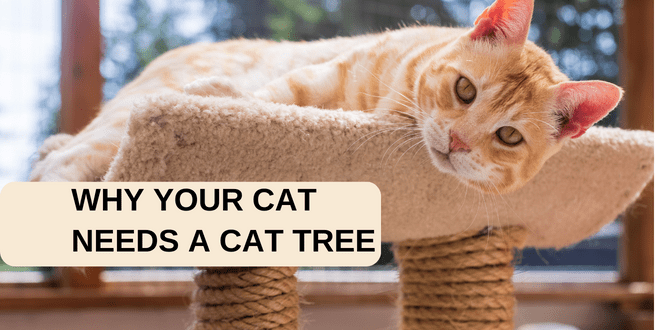
Verticals and Horizontals
We live in a horizontal world but cats aren’t limited to the horizontal side of life. Cats make use of horizontal and vertical aspects of the environment. In fact, they rely on vertical areas for safety, comfort, and certainly for fun. Providing cats with vertical options in their territory isn’t just a luxury, it’s a crucial part of feline life. In a multicat home, vertical territory can make the difference between a happy household and a feline battleground. One of the easiest ways to increase vertical territory is with a cat tree.
When you have more than one cat in your home, the addition of a cat tree increases the chances of living in harmony because cats of higher status can claim the highest perch. If the relationship between a couple of cats in your home is very tense, the ability for the cat of higher status to move to the top perch on a tree can be enough of a display to prevent a physical confrontation. The ability to claim vertical territory may reduce the number of fights and tense stand-offs.

Help for Fearful Cats
If there’s a fearful cat living in your home, the addition of a cat tree can provide a safe place for him to stay out in the open while still feeling secure. On an elevated perch, the cat has a visual advantage because he can see more of his environment and as a result, he’ll have more visual warning time of any advancing opponent. The elevated location also provides security because the cat knows he won’t be ambushed from behind.
If you have a cat who tends to run under the bed and hide, place a cat tree in the room that has an enclosure on one of the perches, so he has the benefit of being elevated as well as being hidden. This may be enough to entice him to stay in the room near family or guests instead of running for cover in the bedroom.
Increased Territory
A cat tree is a great way to increase vertical territory because it provides the opportunity for more than one cat to share a close space while maintaining status. Cats who wouldn’t share close quarters on a windowsill or table, may be at ease enough to share a cat tree. The different levels of the perches allow cats to be close together but not right next to each other.
Initially, a cat tree may seem to be an extravagant purchase but a good quality one will last many, many years. Additionally, a cat tree can serve more than one function for your cat as well. The cat tree is a great place to perch and the support posts can be used as scratching posts. Depending on your cat’s scratching preferences, you can order cat trees with bare wood, sisal covered, or even bark covered.
Which Cat Tree is Best?
When shopping for a cat tree, keep your cat’s size and personality in mind. If you have a large cat, don’t choose a tree with small, flat perches. The cat has to feel comfortable on the perch and not be worried about a leg hanging over the side. Choose a tree with perches that are an appropriate size for your cat. Large cats need large perches. As for the type of perches to look for, my recommendation is “U” shaped ones because they allow the cat to feel the perch against his back. Cats like to back up against things when resting because it helps them feel more secure and lest vulnerable to a rear ambush. If you do opt for a tree with flat perches, at least make sure they’re wide enough for a cat to be comfortable.
Cat trees are easy to find at your local pet product store and online. Prices vary, depending upon whether you want a basic tree or an elaborate one. What matters most to your cat though will be the sturdiness, height, and comfort of the tree. Wobbly trees will not get used by the cat and will be a huge waste of money. The taller the tree, the wider the base should be. When shopping, be certain the tree can withstand your cat leaping from the ground to one of the high perches without so much as a tiny wobble.
Cat Tree Location
Once you’ve purchased the ideal cat tree, give careful consideration to where it should be placed. Typically, a great option is to put the tree by a window so your cat can watch the outdoor activity. If you don’t like the look of the cat tree and plan to place it in some unused bedroom or in the basement, then it’ll just end up gathering dust. The tree needs to be located in a spot that your cat will find appealing.
Another benefit of a cat tree is it can be refuge for a cat who shares his home with children or dogs. If you teach your children that when kitty is on his tree it means he wants to be left alone, it will go a long way in the trust-building process. If your cat shares his home with a dog, train the pup that the cat tree is a dog-free zone.
Another plus is that the cat tree becomes something the cat can claim. It provides ownership because unlike other pieces of furniture in the home, the cat tree will only contain the cat’s scent.
Think Beyond Cat Trees
Increasing vertical territory shouldn’t be limited to just placing a cat tree in your home. There are many other things you can add as well. Beds placed in elevated locations are a great way for cats to have cozy hideaways for naps. Window perches provide easy, inexpensive ways for cats to enjoy bird watching. For older cats who may suffer from arthritis or stiff joints, you can install heated window perches. Just be sure your cat is mobile enough to move away from the heat.
Cat stairs and cat walkways are popular ways to increase vertical territory. This option is great for small environments where there isn’t room for a cat tree. You can purchase cat shelves and walkways or make your own. If you do construct a walkway be sure and put a non-slip material on the surface. Also, in a multicat home, set up a stairway in more than one location so one cat can’t trap another cat on a shelf. Be sure there are no dead end shelves.
Vertical territory can even be as simple as constructing a homemade cat tree with sturdy cardboard boxes. Cut out holes on the boxes, stack them up and secure them with strong tape. Your cat will have a custom-made cat tree that certainly won’t break the budget. When my children were small, we often created cardboard box cat trees. It became a fun family project.
Look around your environment and evaluate whether you’ve truly supplied adequate vertical territory for your cat. With just a little tweaking you can double and triple the size of your cat’s territory and create a more comfortable, secure, and fun home.
Need More Information?
For more information on cat behavior and training, refer to the best-selling books by Pam Johnson-Bennett. Pam’s books are available at bookstores and online. We’ve included Amazon links on our website.





